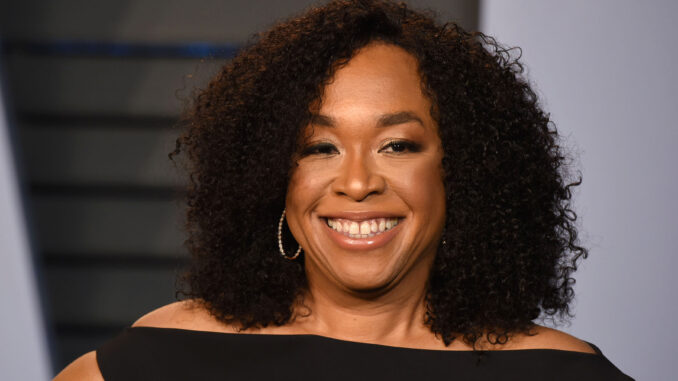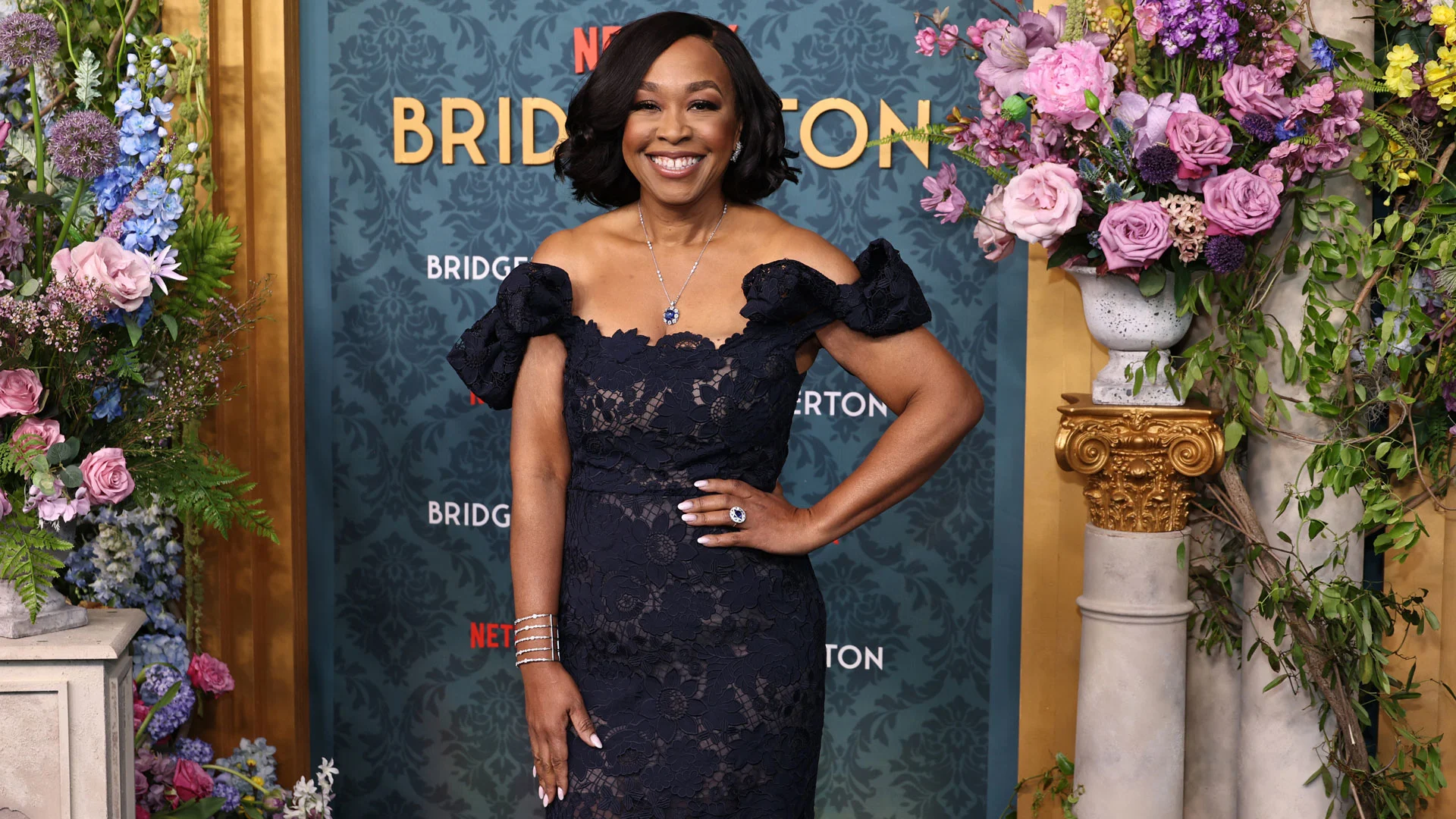
Queen Charlotte: A Bridgerton Story, like its mother series Bridgerton, is the result of careful thinking, loads of research, thoughtful writing, and skillful direction — to say nothing of its meticulously crafted hair and makeup, costumes, and set designs. It’s safe to say that Queen Charlotte creator Shonda Rhimes kinda knows what she’s doing at this point, which is why it might surprise you to learn that some of Queen Charlotte’s most memorable moments — those bittersweet final lines among them — were not exactly planned how we see them now.
Rather, they came to be through spur-of-the-moment choices and happenstance. In fact, the very structure of the series wasn’t planned the way viewers ultimately saw it when its six episodes dropped on Netflix on May 4.
“I thought I was going to write four episodes, maybe three, and that would have been it,” Rhimes told Shondaland. Her past hit shows, Grey’s Anatomy, Scandal, and the recent Inventing Anna among them, were written with a team of writers. After conjuring the idea to tell Queen Charlotte’s origin story, however, she started writing alone, with two episodes (four and five) co-written with Nicholas Nardini.
“When I got into the writing of it, it was really easy to write episodes one, two, and three, but we weren’t even close to being finished,” Rhimes continued. “I don’t think people understand how exhausting it is to write and then have to shape a script for production. It’s a lot of work. We were already shooting. And I was like, ‘We’re moving a little too fast.’ That’s when I brought in Nick. There wasn’t a plan to write them all, but it was the plan when I thought it was going to be a shorter series.”
Rhimes’ unexpected creative choices turned out to be a boon to viewers. Over Queen Charlotte’s six revealing and illuminating installments, viewers gain insight into how young Charlotte (India Amarteifio) came to sit on the throne of the British empire — and how her arranged marriage to King George III (Corey Mylchreest) evolved into an actual love story built on sacrifice, acceptance, and commitment.
When we first met Charlotte in the series, she’s a witty and fierce 17-year-old being whisked away from her native Germany to England to marry a man she hasn’t met. As her brother Adolphus (Tunji Kasim) explains, her marriage is about duty to country and service, and pained as she is, Charlotte accepts her responsibility with chin-up resolving (except of course for that brief moment in episode one when she makes a half-baked attempt to climb over a wall and flee).
As the story unfolds, though, we learn more of all that Charlotte had to face in her new role: prejudice and bigotry, isolation and loneliness, powerlessness over her own body, and yes, the gradual discovery that George is dealing with a serious illness. Rhimes says she wanted to explore how people arrive at love — not so much in the “feelings” sense most of us associate with love, but the practical, sometimes unpleasant parts of love that make love really mean something.
“Long-term relationships,” says Rhimes, “are about constantly overcoming and constantly choosing again, and again and again, to love somebody. It’s a commitment that you make every day. And I wanted to show what that feels like.”
The true essence of the story isn’t what you might think

Although Charlotte and George’s relationship drives the Queen Charlotte plot, Rhimes says their courtship actually isn’t the true guiding concept of the series. “If you really look at the show, all of the moves are made by these women,” she says, referring to the ways Charlotte, young Agatha Danbury (Arsema Thomas), and the king’s mother, Princess Augusta (Michelle Fairley), use their positions to advance their motives despite the constraints they live with as women.
“They’re all basically shaping society and culture from the posts that they have. I just wanted to really show that kind of soft power — how a woman rises to power that way.”
How the Georgian era informed what we see on-screen
As in Bridgerton, Queen Charlotte’s women are tasked with navigating a society that places heavy restrictions on them, but there’s a marked difference between this world and Bridgerton’s: It’s set in the Georgian era. That time period had its own distinctly unique fashion, politics, and culture, which Rhimes learned about by devouring books devoted to that epoch.
One such book was Avril Nanton and Jody Burton’s Black London, which ended up having a significant impact on the characters’ backstory. “It was really exciting for me to read about the many Black composers of the day,” she says. “And many Black society people. I made Agatha and Lord Danbury [Cyril Nri] off the idea that there were African royalty sending their children to boarding schools in England. That was something I’d never known either — that there were these incredibly wealthy Africanscans live in London in a parallel life.”
Another particularly resonant way that chapter of history manifests in the series is through medical science — or more to the point, its limitations. Rhimes says, “That scene where Charlotte’s lying on the bed, and she’s being examined … that scene felt so visceral to me when I was writing it because it was very much all of these other people in control of her uterus. That felt very modern to me, and terrifying that it’s so modern.”
Why Shonda Rhimes was careful depicting King George’s ailments
King George suffered a great deal at the hands of ill-informed doctors too. Particularly in episode four (“Holding the King”), viewers saw in graphic, heartbreaking detail how George’s internal suffering was compounded by the barbaric “treatments” he endured under the care of Dr. Monro (Guy Henry), which by any modern standard would amount to torture. Rhimes and the team took great care to not trivialize George’s condition or even name it, since no real, formal diagnosis ever emerged.
“There have been lots of theories, but there’s never been an actual diagnosis of King George,” she says. “It really bothers me that we run around talking about the ‘madness’ of King George and sort of make fun of it in other storytelling or in other places in history, so I really wanted to try to make that human and humane for him.”
Rhimes’ approach to George’s condition was another element that developed in ways she hadn’t anticipated at the outset. “A lot of how we developed this was, I wrote that first episode scene where he goes running — the big scene where you sort of find out what’s going on with him. I had them film it, and then I watched how Corey physicalized it and wrote from there,” she reveals.
“Because if he found it in his movements and in his portrayal, then I wanted to be able to help keep that in line with the story. I didn’t want to veer off in a different direction. I loved how Corey was portraying it; he gave it a simplicity that didn’t feel over the top, that wasn’t mocking it. It was just right. And so I feel like we crafted that together, although he didn’t know it at the time.”
